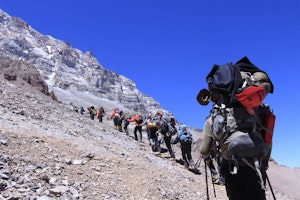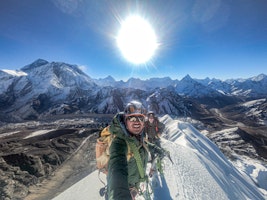The Seven Summits are the highest mountains of each continent. One of the biggest and most popular challenges in mountaineering consists of climbing them and grasping the immensity of each individual mountain, and of the world itself.
So which are these seven glorious continental giants? The list varies according to different mountaineers. These variations are mainly due to different ways of considering territorial divisions. The two most popular lists were put together by Richard Bass, who was the first to complete the seven summits, and Reinhold Messner who was the first to climb Everest solo.
The main difference between the two is regarding the highest peak of Oceania. While Bass posed Mt. Kosciuszko as the tallest summit in Australia, Messner proposed that Puncak Jaya, also known as Carstensz Pyramid was both taller and a more technically difficult peak to climb. We have decided to go by the Messner list because it proposes a more challenging circuit of mountains.
Grouped according to their altitude, the seven summits are:
Mt. Everest (8,850 m) in Asia
Aconcagua (6,962 m) in South America
Denali (6,190 m) in North America
Kilimanjaro (5,895 m) in Africa
Mt. Elbrus (5,642 m) in Europe
Puncak Jaya/ Mt. Carstensz (4,884 m) in Oceania
Mt. Vinson (4,892 m) in Antarctica.
Be forewarned though, the lower ones are not necessarily the easiest! Read on to find out more about each, and start planning your seven summit challenge now!
1. Mt. Everest (Asia)
Mount Everest must be by far the most famous of the seven summits. This is because it is not only the highest mountain in Asia but also, the highest in the world. Located in the Himalayas, this gigantic peak boasts an altitude of 8,850 m.a.s.l. Consequently, climbing to the top is no easy feat.
 seven summits everest
seven summits everest
If you are up for tackling the Everest summit, then consider that the longer the time of ascent, the easier it will be for you to acclimatize. Of course, it goes without saying that going to the top of the tallest mountain in the world is best done with a lot of mountaineering experience and under expert guidance.
Most guided tours to the summit of this giant take around 60 days and tackle the climb from the south side in Nepal as it is overall easier. A good guide will not only know how to gauge the mountain, but they will also handle logistics that really must be carefully planned out from the start.
Keep reading: 10 things you need to know about climbing Everest
The best time of the year to reach the pinnacle of Everest is spring and autumn, that is to say, April to mid-June or September to November. Although the summer is warmer, it is also monsoon season so it is not the ideal time for mountaineering, and winter, of course, is very cold.
 seven summits
seven summits
If you want to try this summit, you will need some heavy-duty training and to have climbed many other mountains before it. However, you don't need to get to the very top to visit Everest. There are shorter treks to the Everest Base Camp which are less demanding, and the Himalayas are a beautiful place that you will definitely enjoy visiting even if you are not a super-advanced mountain climber.
Not an expert mountaineer? find the perfect trek or climb for you in the Himalayas.
On this popular 35-day Himalaya mountaineering course, for example, you can start preparing and training to tackle Everest, or just improve your skills as you get to know the stunning Himalayan region.
2. Aconcagua (South America)
Next up on the seven summit list is the breathtaking Aconcagua. At 6,962 m, it is the highest mountain in the Andes chain and in South America. It is also the second-highest on the seven summit list and the highest non-technical mountain in the world. Therefore, although it is most certainly a mountaineering challenge that many peak-lovers dream of, depending on the route taken, it doesn't require that much prior climbing experience.
As an added plus, Mendoza province is at its foot with bottles of fine wine waiting for the celebration upon the victorious return.
Keep reading: What are the Best Trips to Prepare for Aconcagua?
 Seven Summits Aconcagua
Seven Summits Aconcagua
Aconcagua has two peaks. The North Peak is the highest of the two with an altitude of 6962 m and the South Peak is the lowest at 6930 m. The ascent of the north face via the normal route is the easiest in terms of technical skill, although acclimatization and a good fitness level are essential.
Guided trips to this summit take approximately 20 days, and can also be done at a slower pace which is the best bet for those with less experience. A slightly more challenging route to get to the top of Aconcagua is the Polish Glacier route that takes around the same time to complete as the normal route. Finally, the South Face ascent is a much more challenging route that is usually only tackled by pro mountaineers.
Planning to tackle South America's highest mountain? Here's all you need to know about climbing Aconcagua.
 Seven summits aconcagua
Seven summits aconcagua
Another thing to consider for this climb is the season. The Aconcagua Provincial Park is open from November to March, although the last access is in late February. These are the warm weather months in the Southern Hemisphere, and the high season is from mid-December to the end of January.
Check out different options for guided ascents to Aconcagua!
3. Denali (North America)
Further up north, Mount Denali, in the heart of the Alaska Range, lies at an altitude of 6,190 m. Not only is it famous for being one of the seven summits, but it is also well known for its stunning Peters, Muldrow, Ruth, Traleika, and Kahiltna glaciers. Climbing Denali is challenging, and although the regular West Buttress route is not a technical climb, it is steep and has glaciated terrain. Acclimatization, as with all tall mountains, is key.
 Seven summits Denali
Seven summits Denali
Climbing Denali takes around 20 days. The most common route is the West Buttress, however for an even more challenging climb, you can try the Upper West Rib. For prior training, you can also take this 8-day prep course in Mount Rainier.
In terms of the best climbing season, because of the extreme weather, the climbing season in Denali is from May to late June, with the last week of May being the preferred choice to start the climb. Of course, as with any of the other mountains on this list, it is essential to go with a seasoned guide that knows the terrain and weather.
Take a look at this list of guided tours to the stunning Mount Denali in North America!
4. Kilimanjaro (Africa)
Next up, Kilimanjaro in the Eastern Rift Mountains in Tanzania. This breathtaking dormant volcano lies at an altitude of 5,895 m and is famous for its stunning natural forests and wildlife. Additionally, because the ascent to Kilimanjaro does not require technical skills, it is challenging as any climb, but absolutely doable with proper acclimatization.
 seven summits kilimanjaro
seven summits kilimanjaro







